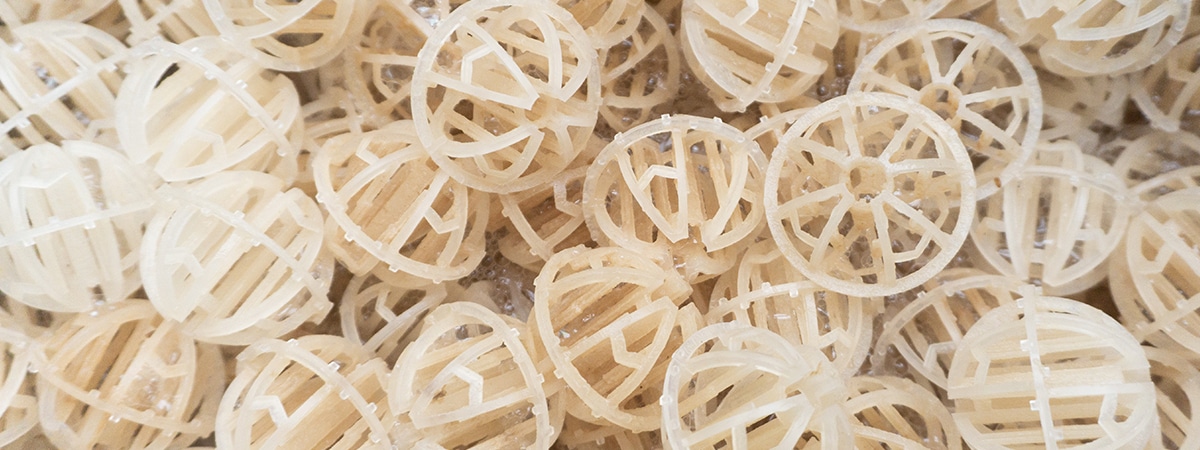Microbiology and technology of denitrification

In closed aquaculture – e.g. in systems with a water exchange of less than 10% per day – the use of denitrification is essential (read more in our blog post Nitrification and Denitrification). Denitrification converts the nitrate (NO3) converted from fish excrements (ammonium/ammonia) during nitrification with the help of special bacteria, the so-called denitrifiers. Molecular nitrogen (N2) is formed from the nitrate in the absence of oxygen, which then escapes from the plant in gaseous form. This is completely harmless to the environment, since the quantities produced are very small and the atmosphere already consists of almost 80% nitrogen.
Denitrification is thus an important sub-process in maintaining water quality and thus contributes to less stress and mortality among fish. Furthermore, it enables particularly low water exchange rates, which are beneficial to the environment.
The denitrification process is relatively demanding and difficult to control. This means that every detail is important in the construction of such a filter:
Biological aspects
Denitrification works only under oxygen exclusion. This is because denitrifiers take oxygen from the nitrate (NO3) (reduction) and, together with a carbon source (C‑source), convert it to more available energy. A distinction can be made between denitrification with autotrophic or heterotrophic bacteria. Autotrophic denitrifiers use the carbon compounds naturally present in water as a C‑source, whereas heterotrophic denitrifiers use a carbon source such as acetic acid (CH3COOH). This makes denitrification filters more efficient, since readily available C‑sources can be used and added very precisely matched to the process. However, measuring technology must always be used to prevent overdosing of the C‑source, as this can have negative consequences for the entire recirculation system. In this case, autotrophic denitrification has an advantage despite significantly poorer efficiency.
Technical aspects
Denitrification can be carried out as a fixed, floating bed or floc reactor. Fixed-bed denitrification is mostly autotrophic, as the bacteria both adhere to the carrier material used for this purpose and also break it down to use it as an energy source. With floating bed denitrifications, fillers are usually made out of plastic, which can move freely in the reactor by means of a pump or agitator. These fillers are only used to adhere on by the bacteria and are not decomposed. A carbon source is added to a floating bed reactor to generate energy. In a floc denitrification, the bacteria accumulations float freely in the water. There are no fillers or similar to which they can adhere. The retention of the bacteria in the reactor is done by a filter at the outlet. Mostly this variant is also operated heterotrophically, e.g. with dosing of a carbon source.
Constructive aspects
The denitrifiers use part of the energy to build up their own biomass. Therefore, it is a great constructive challenge that both the constantly growing amount of biomass can be removed in the meantime (e.g. draining the sediment at the bottom of the tank) and the most homogeneous mixing and thus nutrient supply of the reactor is possible. Especially thick and old biofilms block the reactor and its tubes. In addition, the bacteria in such a biofilm can hardly reach nitrate or carbon, so that the decomposition capacity of the reactor collapses for lack of nutrients.
No matter which type of denitrification is used, each has its own advantages and disadvantages. It is particularly important that the process of denitrification is carefully controlled. Poor design or incorrectly set parameters can affect animal welfare. These include undesirable by-products such as nitrite or hydrogen sulfide, which can be produced in the event of carbon under- or overdosage.
In the SEAWATER Cube, we rely on a floating bed denitrification process with fillers specially adapted and shaped for this process. Due to the higher efficiency, an external carbon source is also used. Automation constantly monitors and controls the denitrification process in order to best avoid risks to water quality and animal welfare.
You need a denitrification tailored to your plant or you have any questions?
Further informationen about Denitrifaction
Check out more facts about the technology. If you have any further questions, please contact us!
References
— van Rijn, J.; Tal, Y.; Schreier H. J.: Denitrification in recirculating systems: Theory and applications. Elsevier B.V., 2005
— Lompe, D.; Wiesmann, U.: Biologische Denitrifikation nitrathaltiger Abwässer und Grundwässer. VCH Verlagsgesellschaft mbH, Weinheim, 1991
— Lee, P. G.; Lea, R. N. et al.: Denitrification in aquaculture systems: an example of a fuzzy logic control problem. Elsevier Science B.V., 2000
— Soares, M. I. M.: Biological denitrification of groundwater. Kluwer Academic Publishers, 2000.
Image source
SEAWATER Cubes